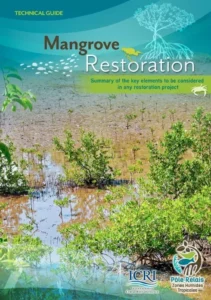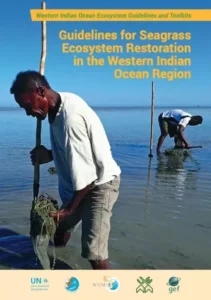Restoration activities are not just taking place in corals. Recently a number of restoration guidelines and management plans have been produced for both mangroves and seagrass beds.
Mangroves
Mangroves are salt-tolerant trees with submerged roots that provide nursery and breeding grounds for marine life, that then migrate to the reef. Mangroves also trap and produce nutrients for food, stabilise the shoreline, protect the coastal zone from storms, and help filter land-based pollutants from run off.
Guidelines on Mangrove Ecosystem Restoration for the Western Indian Ocean Region
These guidelines were produced by the United Nations Environment Programme and the Nairobi Convention Secretariat in 2020. The guide targets communities, civil society, national agencies, and practitioners involved in mangrove conservation activities. The Guidelines provides background information on the mangrove forests and their attributes, as well as the threats they face – both human and natural.
A technical guide to mangrove restoration
The French Tropical Wetlands Network has produced a technical guide on mangrove restoration. The report provides a summary of key elements that should be considered in any mangrove restoration project, based on a review of available literature and practices around the world.
Seagrass
Seagrasses are flowering marine plants that are a key primary producer in the food web. They provide food and habitat for turtles, seahorses, manatees, fish and foraging sea life such as urchins and sea cucumbers and are also a nursery for many juvenile species of sea animals. Seagrass beds are like fields that sit in shallow waters off the beach, filtering sediments out of the water, releasing oxygen and stabilising the bottom.
Eelgrass Restoration on the U.S. West Coast: A Comprehensive Assessment of Restoration Techniques and Their Outcomes
Eelgrass is an important foundation species along the U.S. West Coast, supporting a suite of ecosystem services and functions and providing food and shelter for many fishes and invertebrates. In 2018, PMEP published Eelgrass Habitats on The U.S. West Coast: State of the Knowledge of Eelgrass Ecosystem Services and Eelgrass Extent and compiled a geodatabase of eelgrass presence/absence and current and historic extent of eelgrass in 444 estuaries along the U.S. West Coast. In 2020, PMEP commissioned a report to synthesize eelgrass restoration project successes along the U.S. West Coast to identify best practices for eelgrass restoration and mitigation. The authors of the report reviewed and synthesized data from 51 eelgrass restoration (non-mitigation and mitigation) projects from California, Oregon, and Washington. They identified those methods and approaches that resulted in successful restoration.
Seagrass Restoration Handbook
This Handbook was commissioned by the Environment Agency, as part of the cross-agency Restoring Meadows, Marsh and Reef (ReMeMaRe) initiative in 2022. The Handbook provides foundational and practical guidance on the restoration and conservation of seagrasses and seagrass beds in the UK and Ireland with a focus on the Zostera species: common eelgrass (Zostera marina) and dwarf eelgrass (Zostera noltei).
Guidelines for Seagrass Ecosystem Restoration in the Western Indian Ocean Region
These guidelines were produced by the United Nations Environment Programme and the Nairobi Convention Secretariat in 2020. The guidelines aimed at facilitating capacity building and promoting seagrass restoration in the Western Indian Ocean region, they are practical and concise and are designed for adoption and direct application by seagrass restoration practitioners and other interested parties in the region.





